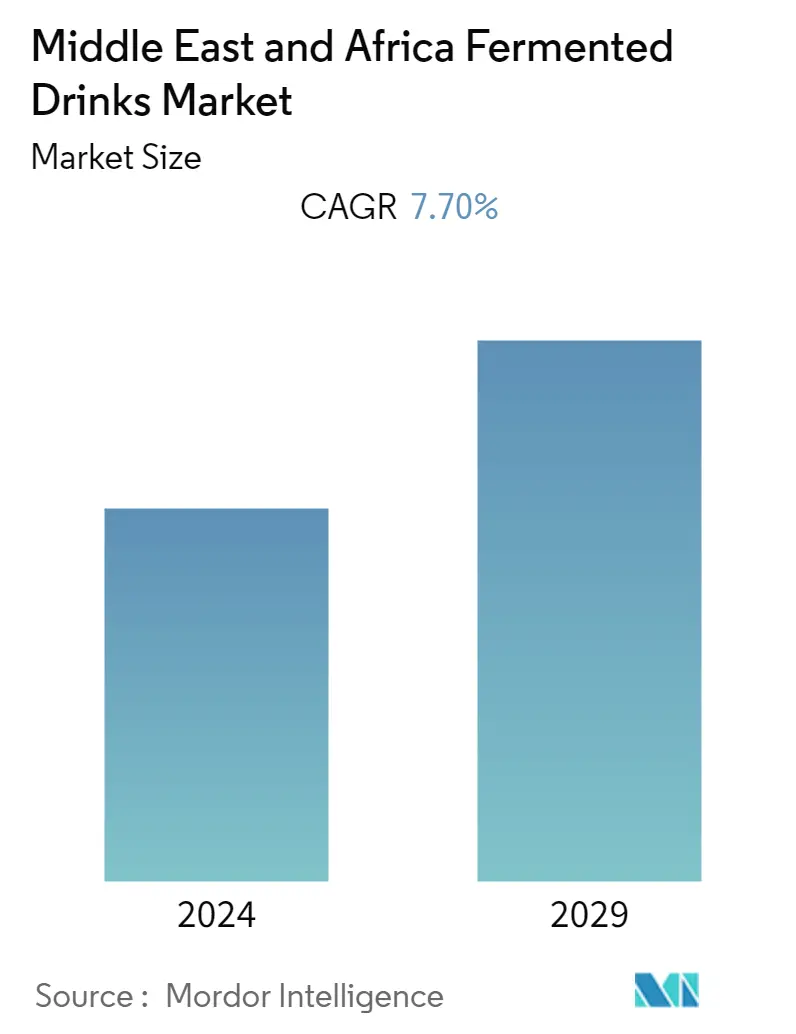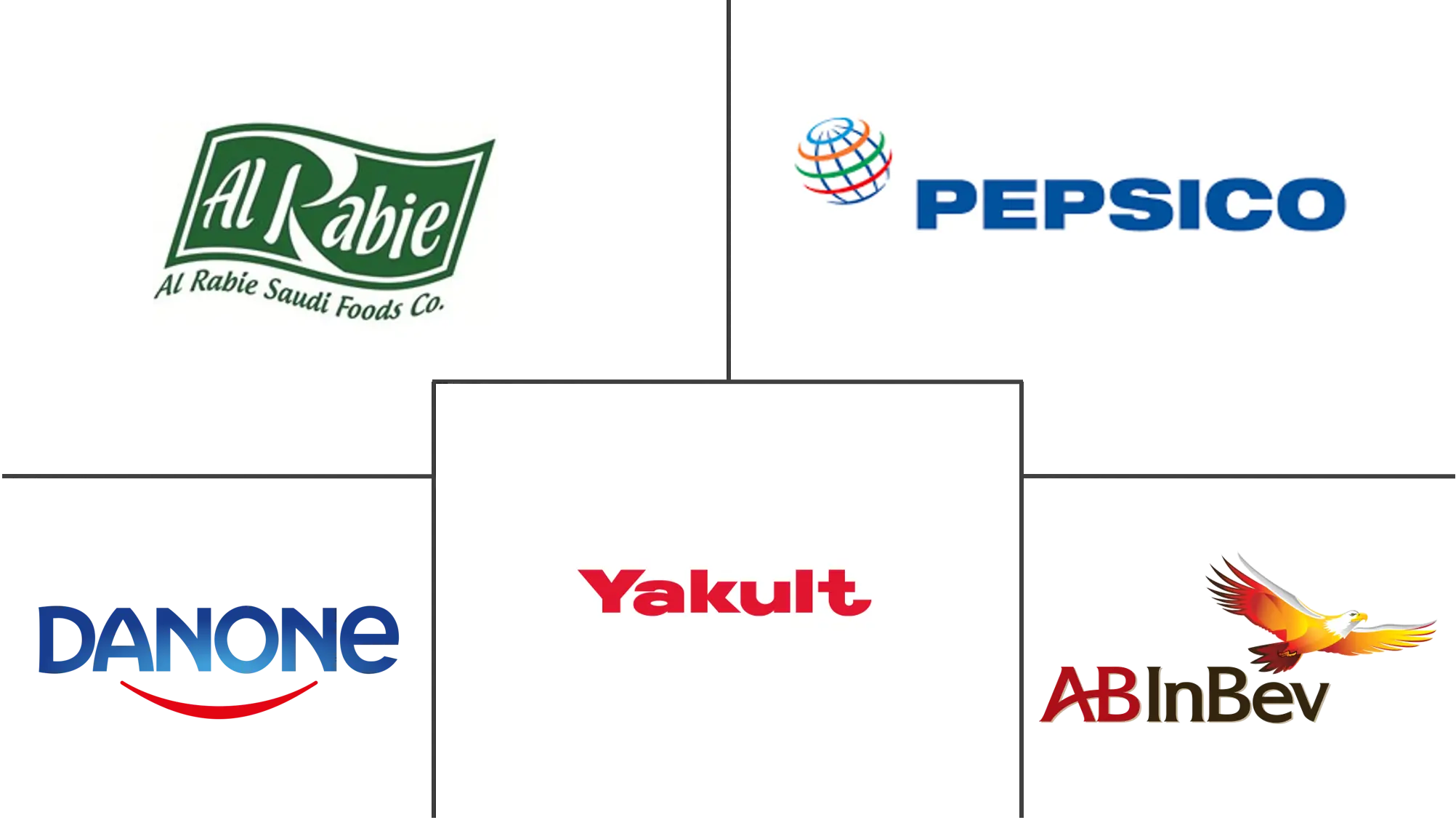Market Size of Middle East and Africa Fermented Drinks Industry

| Study Period | 2019 - 2029 |
| Base Year For Estimation | 2023 |
| Forecast Data Period | 2024 - 2029 |
| Historical Data Period | 2019 - 2022 |
| CAGR | 7.70 % |
| Market Concentration | High |
Major Players
*Disclaimer: Major Players sorted in no particular order |
MEA Fermented Drinks Market Analysis
Middle East and Africa Fermented Drinks market is projected to grow at a CAGR of 7.70% during the forecast period.
- The market witnessed an increase in the number of health-conscious consumers who have been looking for ways of mitigating the negative health effects of increasingly stressful lifestyles and unhealthy eating habits. Moreover, a growing number of consumers are using probiotics drinks such as yogurt, sour milk, kombucha etc. to prevent and manage their digestive and general health issues, which is leading to benefit the fermented drinks market, in terms of sales.
- Furthermore, there is an increase in the number of cases of diabetes, obesity, and gastrointestinal in Middle Eastern countries. Owing to such factors, the global brands are focusing on launching innovative products to cater to the growing demand.
MEA Fermented Drinks Industry Segmentation
Middle East and Africa Fermented Drinks market is segmented by type into alcoholic beverages and non-alcoholic beverages, where non-alcoholic further covers products like kefir and kombucha. The study also focusses on the sales of fermented drinks generated through on-trade and off-trade distribution channels. By geography, the market covers country level analysis of economies like United Arab Emirates, Saudi Arabia, and South Africa.
| Type | |||||
| Alcoholic Beverages | |||||
|
| Distribution Channel | ||||||
| On-Trade | ||||||
|
| Geography | |
| United Arab Emirates | |
| Saudi Arabia | |
| South Africa | |
| Rest of Middle East and Africa |
Middle East and Africa Fermented Drinks Market Size Summary
The Middle East and Africa fermented drinks market is experiencing significant growth, driven by an increasing number of health-conscious consumers seeking to counteract the adverse effects of stressful lifestyles and poor dietary habits. The demand for probiotic drinks, such as yogurt, sour milk, and kombucha, is rising as consumers turn to these products for digestive and general health benefits. This trend is further fueled by the growing prevalence of health issues like diabetes, obesity, and gastrointestinal disorders in the region, prompting global brands to introduce innovative products to meet the expanding demand. Despite the challenges posed by the highly regulated alcoholic beverages market in Middle Eastern countries, which limits sales, the non-alcoholic sector is thriving. Traditional fermented drinks like laban and ayran maintain a strong market presence, with consumers showing a preference for regional delicacies.
The market is characterized by a focus on functional foods that address health disorders, which is expected to enhance the fermented drinks industry further. Key players are investing in research and development to differentiate their products, particularly in the kombucha and probiotic segments, to foster consumer loyalty. Companies like Yakult are expanding their presence in the region, with plans to broaden their distribution networks. The market is consolidated among major players such as Yakult, PepsiCo, and Danone, who leverage their extensive market penetration and diverse product offerings. Additionally, local manufacturers like Nourish Kefir are emerging, aiming to establish a foothold in the growing kefir market. Strategies such as repositioning products on supermarket shelves are being employed to increase visibility and drive sales.
Middle East and Africa Fermented Drinks Market Size - Table of Contents
-
1. MARKET DYNAMICS
-
1.1 Market Drivers
-
1.2 Market Restraints
-
1.3 Industry Attractiveness - Porter's Five Forces Analysis
-
1.3.1 Threat of New Entrants
-
1.3.2 Bargaining Power of Buyers/Consumers
-
1.3.3 Bargaining Power of Suppliers
-
1.3.4 Threat of Substitute Products
-
1.3.5 Intensity of Competitive Rivalry
-
-
-
2. MARKET SEGMENTATION
-
2.1 Type
-
2.1.1 Alcoholic Beverages
-
2.1.2 Non-Alcoholic Beverages
-
2.1.2.1 Kombucha
-
2.1.2.2 Kefir
-
2.1.2.3 Others
-
-
-
2.2 Distribution Channel
-
2.2.1 On-Trade
-
2.2.2 Off-Trade
-
2.2.2.1 Grocery Stores
-
2.2.2.2 Specialty Stores
-
2.2.2.3 Online Stores
-
2.2.2.4 Other Distribution Channels
-
-
-
2.3 Geography
-
2.3.1 United Arab Emirates
-
2.3.2 Saudi Arabia
-
2.3.3 South Africa
-
2.3.4 Rest of Middle East and Africa
-
-
Middle East and Africa Fermented Drinks Market Size FAQs
What is the current Middle East and Africa Fermented Drinks Market size?
The Middle East and Africa Fermented Drinks Market is projected to register a CAGR of 7.70% during the forecast period (2024-2029)
Who are the key players in Middle East and Africa Fermented Drinks Market?
Anheuser-Busch InBev, Yakult Honsha Co., Ltd. , PepsiCo Inc. , Danone S.A. and Al Rabie Saudi Foods Co. are the major companies operating in the Middle East and Africa Fermented Drinks Market.

